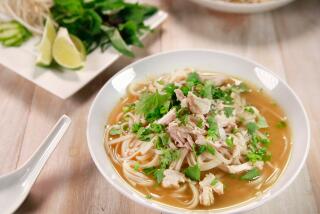More Medical Professionals Try the Alternatives
- Share via
You might think that, after all those years of specialized training, doctors and nurses have discovered some secret formula for fighting that great equalizer of illnesses, the misery-inducing common cold.
Turns out the first-line remedies medical professionals choose for their own scratchy throats and sniffles are time-tested home therapies like hot tea with honey and lemon and steaming chicken soup.
But those on the front lines of the cold and flu wars are increasingly turning to alternatives like zinc lozenges and echinacea, a new survey and the experiences of a couple of Southern California doctors suggest.
The classic prescriptions of rest, plenty of fluids, and an over-the-counter pain reliever and fever-reducer like aspirin, acetaminophen or ibuprofen topped medical staffers’ personal choices for the dog days of a cold.
Other therapies popular when doctors and nurses join the afflicted included vitamin C, echinacea, zinc lozenges--and heeding the wise words of Dr. Mom.
Take the case of Dr. Shirley Uy, an associate professor of family medicine at UCLA. She swallows 500 to 1,000 milligrams of vitamin C a day when she has a cold, “depending on how sore my throat is and how many pills I can swallow.”
“The only reason I use the vitamin C is because my mom tells me to,” confessed Uy, 40, who counts herself among the more fortunate health-care workers because she picks up only one or two colds a year despite a bath of germs at work.
The rest of her regime involves drinking “as much fluid as humanly possible” to avoid dehydration, taking anti-inflammatory medication for fever and a decongestant for a stuffy nose.
Uy takes a traditionalist’s view of zinc lozenges. None will touch her tongue until she sees published results that convince her of zinc’s effectiveness. Ask her about them and she says: “Show me the studies.”
Because doctors and nurses are constantly exposed to potentially bothersome bugs, one big-city doctor wanted to see how colleagues coped with their infections. Dr. Kathi J. Kemper of Children’s Hospital in Boston surveyed doctors, nurses and front-desk staffers at a family medical clinic. Her results appear in the November-December issue of the Archives of Family Medicine.
Findings based on a modest sample of 43 responses indicate that home remedies and other measures once labeled alternative are moving into the practitioners’ mainstream.
Dr. Mary Hardy, medical director of the Cedars-Sinai Integrative Medical Group, a new doctors’ group in Los Angeles that combines traditional and alternative treatments, says the common cold is one illness for which doctors and patients alike will venture outside medical convention. Doctors are willing and “the public is even more willing. Western medicine doesn’t have a magic bullet,” Hardy said.
Hardy reaches for vitamin C, echinacea and sometimes zinc lozenges, although recent studies provide a mixed picture of zinc’s ability to reduce the intensity and duration of colds.
Hardy beat one just three weeks ago in Peru while teaching doctors and pharmacists about plant-based remedies. When she found herself nursing the beginnings of an infection, she began taking echinacea and another Chinese herb, but her chest congestion worsened.
Willing to use the antibiotics she’d packed only as a last resort, she concocted a garlic-onion-sugar syrup and brewed it into a tea.
Garlic and onion, she explained, contain sulfur compounds that have antiseptic, antibiotic, antiviral and anti-inflammatory properties. The mixture, spiked with a little fresh ginger, “really pushed me over the edge” to recovery, she said.
According to Kemper’s Nov. 19 survey, Uy and Hardy’s approaches to their upper-respiratory infections are fairly typical.
Of the survey subjects, 81% used some cold medication. Kemper found 60% of the group favored fever reducers, while slightly more than a third used decongestants.
Slightly fewer than half opted for vitamin C, although 62% were unsure of its helpfulness.
Just over a third tried echinacea, but only a few felt it helped.
A third sucked on zinc lozenges, although two zinc users reported nausea.
Tried-and-true hot tea with honey and lemon proved popular with nearly two-thirds of the staffers surveyed, while chicken soup commanded a one-third following.
As for the elusive remedy of more rest, nearly two-thirds of the clinic staffers reported trying to ease up on their schedules. Although none of them treated their colds with antibiotics, 27% tried the power of positive thinking.
And 12% tried praying their way back to good health.





